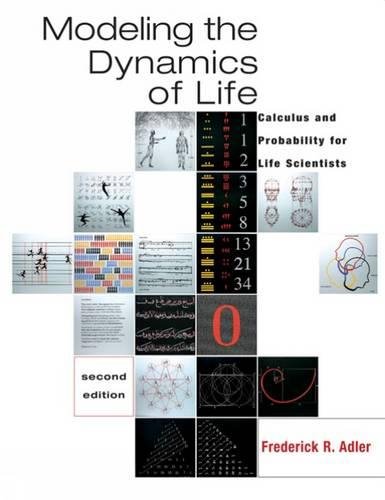
Inhaltsangabe
Understand the role of mathematics in biology with MODELING THE DYNAMICS OF LIFE: CALCULUS AND PROBABILITY FOR LIFE SCIENTISTS with accompanying technology! Designed to demonstrate the importance of mathematics in breakthroughs in epidemiology, genetics, statistics, physiology, and other biological areas, this mathematics text provides you with the tools you need to succeed. The accompanying iLrn testing makes studying easy by allowing you to work with real math notation in real time and providing instant analysis and feedback. Modeling problems, review problems, and over 100 graphing calculator or computer exercises help you visualize and conceptualize key concepts.
Die Inhaltsangabe kann sich auf eine andere Ausgabe dieses Titels beziehen.
Über die Autorin bzw. den Autor
After graduating from Harvard University with a B.A. in Mathematics, Fred Adler received his Ph.D. in Applied Mathematics at Cornell University, where he began his study of mathematical biology. Currently a professor in the departments of mathematics and biology at the University of Utah, he teaches courses in mathematical modeling with a wide range of backgrounds. Prof. Adler's research focuses on mathematical ecology, with emphases in mathematical epidemiology, evolutionary ecology, and community ecology.
„Über diesen Titel“ kann sich auf eine andere Ausgabe dieses Titels beziehen.
Suchergebnisse für Modeling The Dynamics Of Life: Calculus And Probability...
Modeling the Dynamics of Life: Calculus and Probability for Life Scientists (with iLrn⢠Testing) (Available Titles CengageNOW)
Anbieter: BooksRun, Philadelphia, PA, USA
Hardcover. Zustand: Good. 2. It's a preowned item in good condition and includes all the pages. It may have some general signs of wear and tear, such as markings, highlighting, slight damage to the cover, minimal wear to the binding, etc., but they will not affect the overall reading experience. Artikel-Nr. 0534404863-11-1
Gebraucht kaufen
Versand innerhalb von USA
Anzahl: 1 verfügbar
Modeling the Dynamics of Life: Calculus and Probability for Life Scientists (with iLrn⢠Testing) (Available Titles CengageNOW)
Anbieter: ThriftBooks-Atlanta, AUSTELL, GA, USA
Hardcover. Zustand: Good. No Jacket. Pages can have notes/highlighting. Spine may show signs of wear. ~ ThriftBooks: Read More, Spend Less. Artikel-Nr. G0534404863I3N00
Gebraucht kaufen
Versand innerhalb von USA
Anzahl: 1 verfügbar
Modeling the Dynamics of Life: Calculus and Probability for Life Scientists (with iLrn⢠Testing) (Available Titles CengageNOW)
Anbieter: ThriftBooks-Atlanta, AUSTELL, GA, USA
Hardcover. Zustand: Very Good. No Jacket. May have limited writing in cover pages. Pages are unmarked. ~ ThriftBooks: Read More, Spend Less. Artikel-Nr. G0534404863I4N00
Gebraucht kaufen
Versand innerhalb von USA
Anzahl: 1 verfügbar
Modeling the Dynamics of Life: Calculus and Probability for Life Scientists (with iLrn⢠Testing) (Available Titles CengageNOW)
Anbieter: ThriftBooks-Phoenix, Phoenix, AZ, USA
Hardcover. Zustand: Good. No Jacket. Pages can have notes/highlighting. Spine may show signs of wear. ~ ThriftBooks: Read More, Spend Less. Artikel-Nr. G0534404863I3N00
Gebraucht kaufen
Versand innerhalb von USA
Anzahl: 1 verfügbar
Modeling the Dynamics of Life: Calculus and Probability for Life Scientists (with iLrn⢠Testing)
Anbieter: AwesomeBooks, Wallingford, Vereinigtes Königreich
hardcover. Zustand: Very Good. Modeling the Dynamics of Life: Calculus and Probability for Life Scientists (with iLrn⢠Testing) This book is in very good condition and will be shipped within 24 hours of ordering. The cover may have some limited signs of wear but the pages are clean, intact and the spine remains undamaged. This book has clearly been well maintained and looked after thus far. Money back guarantee if you are not satisfied. See all our books here, order more than 1 book and get discounted shipping. . Artikel-Nr. 7719-9780534404864
Gebraucht kaufen
Versand von Vereinigtes Königreich nach USA
Anzahl: 1 verfügbar
Modeling the Dynamics of Life: Calculus and Probability for Life Scientists (with iLrn? Testing)
Anbieter: Bahamut Media, Reading, Vereinigtes Königreich
hardcover. Zustand: Very Good. Shipped within 24 hours from our UK warehouse. Clean, undamaged book with no damage to pages and minimal wear to the cover. Spine still tight, in very good condition. Remember if you are not happy, you are covered by our 100% money back guarantee. Artikel-Nr. 6545-9780534404864
Gebraucht kaufen
Versand von Vereinigtes Königreich nach USA
Anzahl: 1 verfügbar
Modeling the Dynamics of Life: Calculus and Probability for Life Scientists (with Ilrn Testing)
Anbieter: Buchpark, Trebbin, Deutschland
Zustand: Sehr gut. Zustand: Sehr gut | Seiten: 912 | Sprache: Englisch | Produktart: Bücher | Keine Beschreibung verfügbar. Artikel-Nr. 3364546/202
Gebraucht kaufen
Versand von Deutschland nach USA
Anzahl: 5 verfügbar
